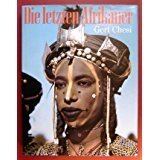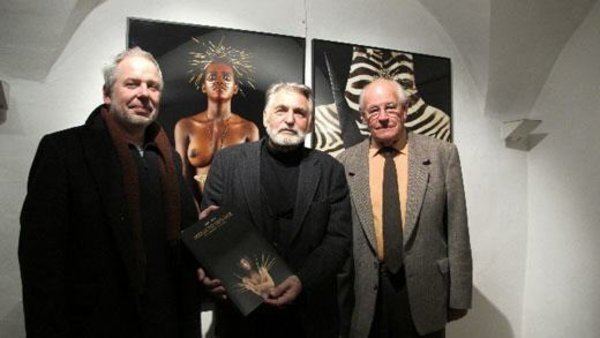Name Gert Chesi | Role Author | |
 | ||
Books Voodoo in Afrika, Die Medizin der schwarzen Götter | ||
Gert Chesi (born 22 August 1940 in Schwaz, Tyrol) is an Austrian photographer, author, journalist and filmmaker. At the end of the 1970s he became internationally famous after publishing the book Last Africans, which was translated into six languages. In 1995 Gert Chesi founded the Haus der Völker in Schwaz, which is a museum for tribal art and ethnography.
Contents
- Early life
- Life as Collector and Ethnograph
- The 1980s
- Haus der Vlker
- Later life
- Documentary film
- Museum der Vlker
- Honors
- Writings by Gert Chesi
- References

Today Gert Chesi lives in Togo, Thailand and Austria.
Early life
In 1959 Gert Chesi started to work as an independent journalist and photographer for local newspapers. In 1960 Chesi founded Studio 12, the first Jazzclub in Schwaz, a city in the western part of Austria. In 1962 Gert Chesi founded the gallery "Eremitage Schwaz", which was transformed into a Jazzclub in 1974.
In 1963 Chesi started to work for the Austrian Broadcasting Österreichischer Rundfunk as a freelancer and organized Schwazer September, an Austrian music and cultural festival.
Life as Collector and Ethnograph
In 1964 Gert Chesi moved to Lambarene in Gabon to stay with Albert Schweitzer at the Albert Schweitzer Hospital. Gert Chesi published articles and photos about Albert Schweitzer and his work in Africa. At this time Chesi started to collect tribal art.
From 1965 he wrote several publications about art and ethnographic topics in international media and the Austrian Broadcasting Österreichischer Rundfunk, and was present in subsequent series of the TV station. In 1969 Gert Chesi hosted an exhibition about African art, organised a lecture tour in Germany and Switzerland and exhibited his photographs in several exhibitions in Germany, Austria and Switzerland.
Gert Chesi went on long journeys through India, Africa and America. He recorded a world music double-album under the title Black Magic. In 1975 a first picture book followed under the name Last Africans, which has been published in six languages. Several exhibitions and presentations followed this publication. One was an exhibition about African art from the Chesi collection in 1977 in the Musee des beaux Arts in Grenoble and another one in the Gallery Numaga in Switzerland. In the same year Gert Chesi published texts and pictures in the magazines GEO, Stern, Ambiente and other scientific publications.
The 1980s
In 1987 he conducted extensive studies about Voodoo in Africa and Haiti. His picture book Voodoo: Africa's Secret Power has been published in four languages. After several studies and work journeys to the Philippines and Africa, Gert Chesi published the book Faith Healers in the Philippines. Further, he worked on the Encyclopedia Togolais on behalf of the state president. After several more journeys to Africa he published Medicine of the Black Gods (German: Die Medizin der schwarzen Götter) and he co-authored Africa - Enthralled by a Continent (German: Afrika - Im Banne eines Kontinents) and Colon - the black picture of the white man (German: Colon - Das schwarze Bilde des weißen Mannes). In 1983 the book Susanne Wenger - A Life with the Gods in Their Yoruba Homeland (German: Susanne Wenger - Ein Leben mit den Göttern) followed.
The following year he was contracted by the University of Innsbruck where he taught photography at the institute of interior design for 10 years. In the same year an exhibition was held in the Munich Stadtmuseum and the catalogue "Art of the wizards" (German: "Kunst der Zauberer") was published.
In 1985 Chesi travelled to Bali, Togo and Thailand for German publishers. In the following year several photograph exhibitions were held in different international galleries and museums. A black and white catalogue about his exhibition in the new gallery of the city Linz has been published. Another year later he exhibited in the Burgenland provincial exhibition. A coloured catalogue has been published for the exhibition "Theatre of exaggerations" (German: "Theater der Übertreibungen") and further Gert Chese published in several professional journals and travelled to India, Ladakh, Africa and Brazil.
In 1988 the Museum der Weltkulturen, Frankfurt bought Chesi's ethnological photo archive from 1973.
Haus der Völker
In 1994 he started preparing his work for the "Haus der Völker" in Schwaz, which opened in 1995. At the same time the book Architecture and Myth (German: Architektur und Mythos) was published and the ORF produced a film about Africa with Chesi. Gert Chesi's son was born in 1995 too.
Since the inception of the "Haus der Völker" Gert Chesi has been director. The institution hosted several special exhibitions. At the same time Chesi held several lectures about different ethnological topics, and eight exhibitions outside of the "Haus der Völker" were hosted. He undertook further journeys to study in Africa and Asia.
Later life
Gert Chesi prepared another book called Trance and Possession Cults in West-Africa (German: Trance und Besessenheitskulte in Westafrika). Study journeys brought him to Togo, Thailand, Burma and Ghana.
In 1998 his first CD of the series "The Sound of Africa" (The Sound of Voodoo) was produced. The "Haus der Völker" took part in the exhibition "Cults, Artists, Kings" (German: „Kulte, Künstler, Könige") in the Castle Museum Linz and in the exhibition "Power of Women and Domination of Men" (German: „Frauenmacht und Männerherrschaft") in the Rautenstrauch-Joest Museum in Cologne. On behalf of the German-Chinese Society he traveled to China and Asia on several occasions to select exhibits for the exhibition "2000 Years of Silk Road" in collaboration with Mrs. Prof. Dr. M.Yaldiz, Director of the Museum of Asian Art Berlin - Dahlem. In 1999 he worked on the preliminary studies of the book Voodoo in Africa. Chesi traveled to West Africa to prepare the exhibition "2000 Years of African Ceramic" (German: "2000 Jahre afrikanische Keramik"). On behalf of the city Schwaz, he organized two exhibitions with the title "The Spirit of Silver" on the occasion of the 100 year festival of becoming a city.
After a severe heart surgery in 2000, Chesi traveled to Africa and Asia on several occasions. After an extensive trip to China the preparations of the exhibition "Textile Art of Chinese Mountain Peoples" (German: „Textile Kunst chinesischer Bergvölker") were completed. The concept of "Buddha in Art and Myth" (German: "Buddha in Kunst und Mythos") was realized; the exhibition was opened in March. During the same year, Gert Chesi discovered a significant sculpture of the Nok and acquired it for the "House of the People". In collaboration with the Museum of Ethnology, Hamburg he opened a huge exhibition about Japan.
In 2002 his autobiographical book Africa in ones Heart (German: Afrika im Herzen) was published by Haymon. One year later his book Voodoo in Africa was published by Haymon, as well. In 2005 Gert Chesi moved his main-residence to Togo and assigned the operative part of „Haus der Völker" to a new newly founded cultural association. Within the same year, he published his first German Magazine of Non-European art in collaboration with Gerhard Merzeder: MAGAZIN A4 which is issued twice annually. In 2006 Merzeder and Chesi designed their first extensive photo book about the culture of the Nok. He produced two movies about Africa. During the years 2007 to 2010 he hosted several exhibitions in the "Haus der Völker" and published various catalogue essays. He further engaged in African traditions. In 2010 the book Africa- Magicians of the Earth (German: Afrika – Die Magier der Erde) was published by Studienverlag. After extensive trips to Thailand, India and Africa, he published Views of humankind in other worlds (German: Menschenbilder aus anderen Welten). An exhibition series of these images started in January 2012 in Rabalderhaus in Schwaz. In February 2012 the photographs of Gert Chesis were displayed in the Institute Francaise in Togo.
Documentary film
2013 Gert Chesi started to produce documentary films about tribal and religious traditions in Africa and Asia.
Museum der Völker
After a comprehensive remodeling of the Haus der Völker, the Museum der Völker (German: Museum der Völer) was opened on 12 April 2013.
